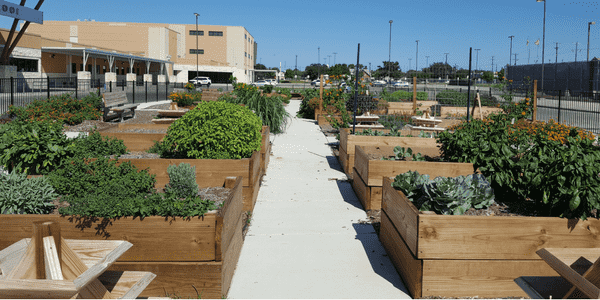Roosevelt High School could have hired designers, architects and landscapers to plan, build and maintain their gardens. Instead, they turned to the kids, staff and community members.
“In the early planning stages, some contractors said they could come in and get it done in a day,” recalls Garden Coordinator and Science Teacher Misty Belmontez. “But I said, ‘That’s not the point.’”
Instead, Misty recognized an opportunity to delegate each phase of planning and building to students who specialize in related areas of study. “This way the kids learn so much more by making connections to the world around them,” she says.
At the high school level, many students are mature enough to take on adult-level projects—and that kind of experience can build confidence, develop leadership and collaboration skills, and expand their practical knowledge of a subject area.
First, Misty approached Advanced Architecture Teacher Katy Philbrick, and invited her students to submit proposals for an overall design plan.
“The kids created designs and renderings for the entire garden. It was a collaborative process,” Katy explains. “Multiple students submitted proposals. Each proposal was evaluated, strengths were identified, and the group came back together to combine their best ideas all into one final design. They figured out everything, including ADA (Americans with Disabilities Act) compliance.”
“The kids created designs and renderings for the entire garden. It was a collaborative process.”
As this master plan took shape, additional funding came through, and science club students were invited to add their ideas.
“Science students also got involved and looked more closely at where to place the different garden beds for success,” says Environmental Science Teacher Cynthia McKinney.
Next, it was time to build. For this phase, about 10 more student groups jumped into action, including athletics, ROTC, National Honors Society and others.
“I reached out to all campus groups that required students to earn community service hours. Part of our mission was to build a shared ownership on campus,” Misty explains. “We need everyone invested in the garden. Otherwise, how would we sustain it?”
Students learned all sorts of hands-on skills during the construction and planting process, ranging from how to use a drill and a measuring tape, to how to construct a garden bed, and where to install specific plant varieties.
The resulting design has 36 raised vegetable and herb garden beds, all of which are 24 inches high for wheelchair accessibility; several additional ground-level beds with native Texas plants; 4- to 5-foot-wide cement paths next to all raised beds; and mulch paths winding through the ground-level beds.
Eagle Scout Adam Arnwine built benches for three learning areas, where students can settle in during garden-centered lessons.
Having established a high level of student involvement from the get-go created a lot of interest and momentum for keeping the garden going—and taking it to the next level.
Planting and maintenance became a core part of the curriculum for environmental science classes. The special education community vocation class adopted several beds to maintain and grow vegetables. An after-school community garden club also helps regularly with maintenance and weeding, and harvests vegetables to make recipes.
The student international club is adding multilingual signage that reflects the 20 plus languages spoken on campus. The signs include QR codes that provide more information about each plant or garden. Students are investigating the use of a 3-D printer or metal engraver to make more permanent signs and possibly add braille.
“Students are researching how we should make the signs. Should we use plastic or metal? Which is more cost effective? Which lasts longer?” Misty says. “They learn so much just having to take responsibility for researching details. Something simple, like what kind of shovel to buy, becomes a learning experience. The kids could see that they could get a $10 shovel that won’t last very long, or they could spend more up front on a $30 shovel with a lifetime warranty.”
Valuable life lessons like this will stay with students far beyond their high school years. Meanwhile, it’s an opportunity to develop skills and build community.
“I want everyone in our community to realize the garden is not just a science thing,” Misty says. “We are actively incorporating as many stakeholders as possible. I want our garden to be a living legacy. By having shared ownership, we will make sure that happens.”



